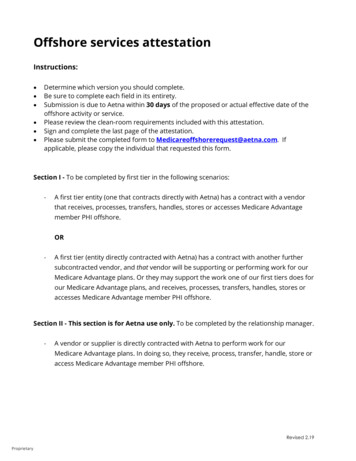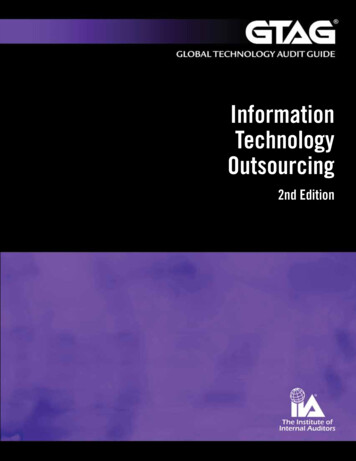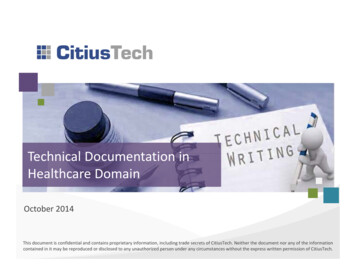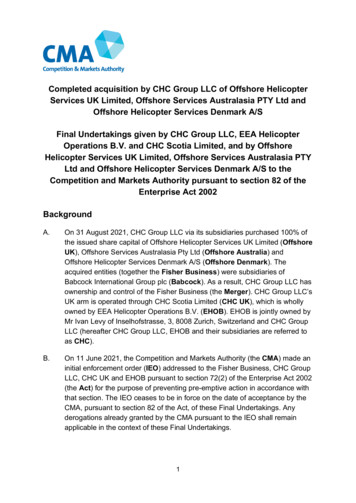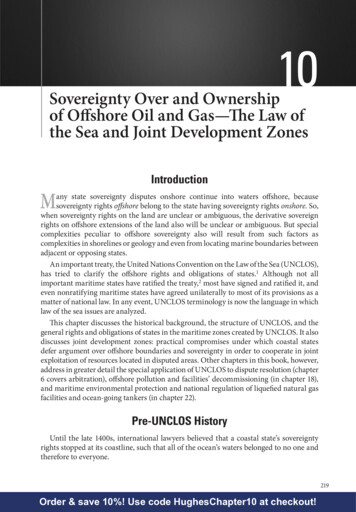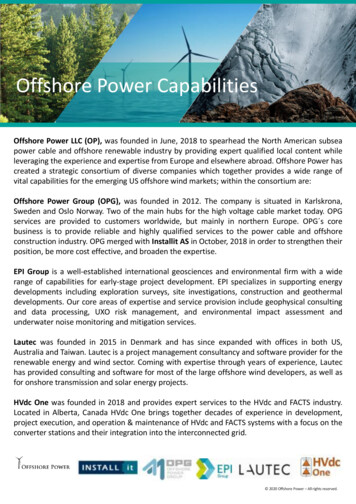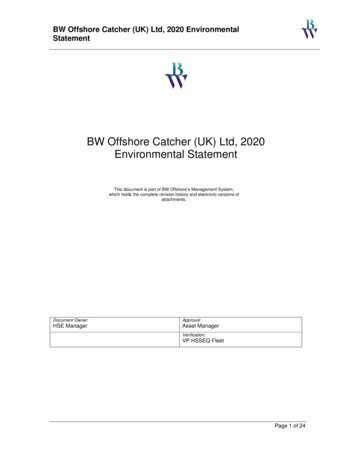
Transcription
Summer 2004 (August)Volume 7Issue 2A Publication of the American Health Lawyers Association Health Information and Technology Practice GroupTABLEOFCONTENTSOffshore Outsourcing ofPHI Processing: Is it Permitted Under HIPAA?John Christiansen, JD . . . . . . . . . . . 1The Health InformationLaw Roller CoasterKristen Rosati, Esq. . . . . . . . . . . . . .6Congress, Administration Off to a Good Starton eHealth: Now What?Bruce Merlin Fried, Esq. . . . . . . . . . 7Silver Hippo AwardDonald Koenig, Esq. . . . . . . . . . . . . 8The eHealth Initiative’sReport on ElectronicPrescribing: The Message for HIT LawyersPatricia King, Esq. . . . . . . . . . . . . . 9Reconciling HIPAAPrivacy and SecurityCompliance—A BriefRoad Map Toward Security Rule ComplianceKenneth Schuman, Esq. . . . . . . . . . 12Chair ReportMarilyn Lamar, Esq. . . . . . . . . . . . 15Year-in-Review2003-2004Edward Shay, Esq. . . . . . . . . . . . . 16Leading Health Law to Excellencethrough Education,Information, and DialogueHIT News 2004 is published by the AmericanHealth Lawyers Association.All rights reserved. Nopart of this publication may be reproduced in anyform except by prior written permission from thepublisher. Printed in the United States ofAmerica.“This publication is designed to provide accurate and authoritative information in regard to the subject matter covered. It is provided with the understandingthat the publisher is not engaged in rendering legal orother professional services. If legal advice or other expertassistance is required, the services of a competent professional person should be sought.”—from a declaration of the American Bar AssociationOffshore Outsourcingof PHI Processing:Is it Permitted UnderHIPAA?1John R. Christiansen, JDPricewaterhouseCoopersSeattle, WashingtonOffshore outsourcing of technology-related jobs andfunctions is a controversial subject, and a partisan one in thiselection year. It is also an important one for many healthcareorganizations,2 for reasons thathave nothing to do with politics.This article does not take aposition on the virtues or vicesof offshore outsourcing in general. Rather, it reviews the compliance obligations and risks ofhealthcare organizations thatmay want to outsource functionsinvolving the use or obtainingof protected health information(PHI) by offshore BusinessAssociates or subcontractors.Offshore outsourcing raises substantial issues not only of HIPAAcompliance but also in somecases of national security. Thefundamental question is, whatobligations does a CoveredEntity or Business Associatehave to ensure that an offshoreservices provider is trustworthy,and that the services provider’shost nation has a legal infrastructure that will allow it toenforce the data protection obligations imposed by Americanlaw? The short answer is thathealthcare organizations probably do have a regulatory obligation of due diligence in theseareas, and that in any case itwould be prudent to act as ifthey do.I. The “Data Haven” andBusiness AssociateProblemsThe problem of data “escaping”from legal protections is not anew one. Way back in 1988—almost prehistoric times in theevolution of information technology—science fiction writer BruceSterling postulated the development of lawless “data havens.”3The privacy law equivalent oftax havens, data havens—islandnations, perhaps, with small populations and otherwise minimaleconomic prospects—wouldrefuse to enforce other nations’privacy laws, allowing for “regulatory arbitrage” by organizations or individuals seeking touse or disclose protected information in ways not permitted inmost jurisdictions.4The international nature ofdata flows limits the abilityof any single nation to enforce its data protectionlaws. . . . [E]ven a highlyorganized internationaleffort to control data flowscould be undermined by adata haven—the informationequivalent to a tax haven—asingle nation that offered towarehouse data.The existence of a data haven would undermine dataprotection laws in severalways. It could be used tostore information about individuals that was illegal tostore elsewhere. The owners, or the clients, couldengage in massive “datamining” to cross-index thatinformation. It could eithermarket the data to companies unable to compile thedata themselves, or firmslocated in the data havencould provide services—forexample, direct marketing,detailed asset information,or consumer profiles—thatcompanies located elsewhere are forbidden toacquire or provide. . . .[O]nce information leaks oris quietly sold to a datahaven, it may be difficult totrace the leak to its source,and it is likely to be impossible to take action againstfirms located in the haven.5The European Union confronted and tried to solve this problem in developing its own dataprotection laws, under theEuropean Union Data ProtectionDirective (EU Directive), whichrequires all entities to protectpersonal data.6 In order to avoidthe data leakage problem, thedirective prohibits the transfer ofprotected data from memberstates to jurisdictions, like theUnited States, that do not havelaws protecting personal data toan equivalent or greater degree.7However, the practical need ofmany multinational organizations to transfer protected databetween the United States andEurope led to a somewhat awkward legal work-around. UnderContinued on page 2
Continued from page 1the “Safe Harbor” rules, organizations in the United States mayvoluntarily opt-in to a set ofdata protection obligations thatmeet European Union requirements, subject to enforcementby the US Federal Trade Commission or other agencies.8HIPAA suffers from the samekind of problem, since as a jurisdictional matter it can onlyregulate the activities of healthplans, healthcare clearinghouses,and healthcare providers thatparticipate in covered electronicclaims transactions (i.e., “Covered Entities”).9 Since few if anyCovered Entities could operatefor long without using servicesfrom non-regulated entitiesinvolving the use of PHI, whoseuse and disclosure of PHI couldnot be directly regulated underHIPAA, the privacy regulationspermit Covered Entities to do soonly under limited conditions,including in particular a requirement that Covered Entitiesestablish a Business AssociateContract with any entity thatobtains or uses PHI on behalf ofthe Covered Entity. Indirectly,then, the HIPAA regulationsprotect PHI by requiring Covered Entities to pass along theirown data protection obligations.The HIPAA Business Associateworkaround is therefore intended to prevent the “escape” ofPHI from non-covered entity“data havens,” just as the EUDirective Safe Harbor rules areintended to prevent the “escape”of personal information fromorganizations operating innations with less stringent dataprotection laws. But the Business Associate rules do notaddress the question of the via2bility of this workaround whenthe enforcement of BusinessAssociate Contracts may beproblematic. In considering thisissue, it may be useful to clarifywhat we mean by offshore outsourcing and its risks.II. Offshore Outsourcing ofHealthcare Functions“Outsourcing” refers to a delegation of responsibility andownership of functions and resources along a spectrum fromtraditional, complete ownershipto nearly complete divesture bythe primary party.“At a high level, there are fourgeneral sourcing options: Insourcing—Using internalresources under internalmanagement Buy-in—Bringing in externalresources to run under inhouse control Traditional outsourcing—Supplier taking ownership ofcustomer resources and managing those resources onbehalf of a customer ASP [application services provider]—Renting supplier-ownedresources to customers anddelivering over the Internet.”10Even analysis along this spectrum may be too simplistic,however, since outsourced services providers may themselvesfurther outsource their owninfrastructure or functions theyhave contracted to provide.Most customer-supplier relationships in this space arevery complicated. A netsourcing [sic] supplier mayhave primary accountabilityto a customer, but hardware, monitoring, billing,help desk, and support serv-ices may actually be subcontracted to others. This subcontracting, of course, presents more risks to customers,who may not even be awareof the subcontracting. It alsoposes more risks to netsourcing [sic] suppliers, whoremain accountable forproducts and services outside their direct control.11In this context, offshore outsourcing refers to the transfer offunctions and activities to organizations in other nations wherewages and other costs areexpected to be lower. The concept is not new but the processhas been considerably facilitatedin recent years by the availability of the Internet and the development of data centers andrelated facilities in nations withsufficient technologically trainedpersonnel to support them.12The provision of outsourcedservices to U.S. companies waspioneered in India, which hashigh numbers of well-educated,English-speaking professionals,but India’s lead is rapidly beingfollowed by other nations inAsia, Eastern Europe, andCentral and South America.13While the national securityimplications of outsourcingsome kinds of defense-relatedfunctions are beginning to getrecognition,14 privacy issues arealso emerging as a focus ofpotentially serious concern. Afew recent incidents havealready stimulated some legislative activity, and even in theabsence of new legislation raiseserious issues for healthcareorganizations outsourcing PHIrelated services offshore—aswell as their potential responsibility for ensuring their onshoreservices providers do not out-Health Information & Technology Practice Groupsource offshore without appropriate controls.The same factors that make outsourcing attractive in general canmake it appealing to healthcareorganizations too, so it is no surprise that many are entering intosuch arrangements. Clinical transcription services seem to be theleading PHI-related function thathealthcare organizations aremoving offshore to date,15 butother functions are following.16But unless the kinds of controlproblems already experienced inthe transcription sector can beadequately addressed, the risksof offshore outsourcing mayoften outweigh the benefits forany PHI-related function.The most notorious incident todate, and one emblematic of theproblems posed by offshore outsourcing, involved the blackmailof the University of California atSan Francisco Medical Center(UCSF) by a Pakistani transcriptionist—though based on published information, the transcriptionist herself appears to havebeen far more ethical and businesslike than some of the Americans involved.17 ApparentlyUCSF had contracted for sometwenty years with an establishedCalifornia transcription service.This service subcontracted someof its work to a transcriptionistin Florida, who in turn subcontracted with another in Texas,18who in turn subcontracted withthe Pakistani transcriptionist.When the Pakistani transcriptionist was not paid for her services, she emailed UCSF a threatto publish patient records onthe Internet. UCSF initially hadno idea who she was, and ittook some sleuthing to trace thechain of relationships that led tothe threat. This apparently trig-
gered some payments to thePakistani transcriptionist, whothen retracted her threat. Unfortunately, published informationto date does not discuss theterms of the various contracts inthis chain, though it appearsthat the UCSF-transcription service contract may not have permitted offshore subcontracting,and that the transcription service-Florida transcriptionist contract may not have permittedfurther subcontracting. To date,there appears to be no information about possible legal actionsagainst any of the parties.Publication of the story aboutthe UCSF incident was quicklyfollowed by publication of areport indicating that an Ohiobased transcription companythat routinely outsources to Indiahad also experienced an extortion attempt, in this case by twoof its own offshore employees.19Another story reported that acomputer systems administratorfor a major Veterans Administration transcription contractorhas alleged that it had servicesperformed offshore, contrary tocontract requirements, and thatsome of the records sent offshore included highly sensitivemilitary information.20Following publication of thesestories some legislators havestated their intent to introducelegislation regulating offshoreoutsourcing of functions potentially involving personal information.21 Whether or not suchlegislation is ever passed, existing HIPAA requirementsalready seem to prohibit healthcare organizations from doingso under some conditions.III. Risk Management andthe Outsourcing ofPHI-Related ServicesHIPAA expressly contemplatesthat Covered Entities may outsource PHI-related functions,since by definition, any party towhich a Covered Entity outsources a function involving the obtaining or use of PHI on behalfof the Covered Entity is thatCovered Entity’s Business Associate.22 It also contemplates thatBusiness Associates may subcontract PHI-related functions, sincethe Business Associate Contractprovisions include a requirement that PHI use and disclosure restrictions be passed on toany subcontractor.23A minimalist interpretation ofthese provisions might suggestthat the only condition to offshore outsourcing of PHI-relatedfunctions by a Covered Entity isa Business Associate Contractincluding the provisions specifically stated in the rule, in thelanguage of the rule. A minimalist interpretation might alsosuggest that the only conditionto offshore subcontracting by aBusiness Associate is that thesubcontract include a use anddisclosure limitation provisionthat mimics the primary BusinessAssociate Contract’s use anddisclosure provisions. Under thisinterpretation, neither CoveredEntity nor Business Associatewould have any duty to assesswhether an offshore servicesprovider is trustworthy and hasappropriate safeguards to protect PHI, or consider whether itscontract is likely to be enforceable against the services provider.This interpretation would treatthe Business Associate Contractprovisions as a safe harbor: Aslong as there is a contract inplace that includes the provisions listed in the regulations,there can be no compliancefailure. This kind of minimalistinterpretation is not the mostprudent one, however, and maynot be correct.Under HIPAA Covered Entitieshave a specific statutory obligation to maintain “reasonable andappropriate administrative safeguards” to protect PHI against“any reasonably anticipated”threats to the security of, or “unauthorized uses or disclosuresof” the information,24 while theprivacy regulations require aCovered Entity to “reasonablysafeguard [PHI] from any intentional or unintentional use ordisclosure” that would violatethe privacy regulations.25“Safeguards” means “securitymeasures,” and with the publication of the HIPAA securityregulations it has become clear—if it was not before—that in orderto determine what safeguardsare “reasonable,” Covered Entities are required to assess theirsecurity risks, and implementappropriate measures to manage them.26 Since the risk assessment is required to be “accurateand thorough,”27 if the CoveredEntity is aware of potential outsourcing risks—including thosementioned in this article—theseneed to be included when assessing any outsourcing arrangement. If the risk assessmentfinds that the arrangement creates any “reasonably anticipatedthreats” of unauthorized disclosure or use of PHI, the CoveredEntity will need to implement“reasonable safeguards” thatreduce the anticipated threatsto a “reasonable and appropriate level.”28This does not mean that Covered Entities cannot outsourceactivities involving PHI offshore.It probably does mean that offshore outsourcing cannot bedone without safeguards aboveand beyond the Business Associate Contract provisions thatgenerally suffice where all entities and activities are located injurisdictions where the legal system enforces contractual obligations with reasonable certaintyand timeliness.This implies a set of due diligence obligations for CoveredEntities outsourcing PHI-relatedactivities offshore.29 (Note thathealth plans already have anobligation of due diligence withrespect to all services providers,in all states that have adoptedthe “Standards for SafeguardingCustomer Information ModelRegulation” published by theNational Association of InsuranceCommissioners.30 While the specific obligations will be drivenby analysis of the specific riskspresented by a specific outsourcing arrangement, as a generalrule they should probably include: A data criticality analysis31that considers whether thePHI involved might includeparticularly valuable or sensitive data, such as informationabout care provided to military personnel, demographicdata on senior defense or national security personnel, etc.32 A background check (including references) for anyprovider of PHI-related services, to identify any risk factors arising from past performance (or lack thereof).33 An independent assessmentof the services provider’sContinued on page 4healthlawyers.org3
Continued from page 3administrative, physical, andtechnical safeguards for theprotection of PHI. Confirmation of entity statusand availability for service ofprocess. Determination of the jurisdiction whose laws will apply,and venue for any action toenforce contractual provisions. Contractual provisions thatspecify the services provider’sobligations in detail, and aright to audit contractualcompliance at the CoveredEntity’s discretion.34 Establishing an incident response plan for dealing withsecurity and privacy breaches.35 A prohibition on any subcontracting without the CoveredEntity’s prior approval (preferably at the Covered Entity’sdiscretion). This might beprudent in any BusinessAssociate Contract, even withdomestic services providers,where there is a risk theBusiness Associate may outsource to a less trustworthyentity, offshore or otherwise.Any Business Associate Contractmade in contemplation of outsourcing should also have indemnification, limitation of defense,choice of law, jurisdiction andvenue, and attorneys fees provisions that protect the CoveredEntity in case of any breach, tothe greatest extent possible.IV. ConclusionOffshore outsourcing may wellbe a financially appropriate, ifpolitically sensitive solution formany healthcare organizations,and this article should not betaken as a brief for its prohibi4tion. But as seems to be the caseso often with information technology solutions, the devil is inthe administrative and operational details, and the regulatorycompliance and risk managementburden may be much more substantial than it seems at firstglance. Healthcare organizationsshould at least exercise greaterthan ordinary diligence in outsourcing PHI-related functionsoffshore, and should avoid doingso at all to nations where the enforceability of Business AssociateContracts may be problematic,or to entities that seem less thandemonstrably trustworthy.Endnotes1 This article assumes that the reader has at least a basic familiaritywith the Health Insurance Portability and Accountability Act of 1996and the privacy and security regulations published pursuant to it (collectively HIPAA in this article).2 The term “healthcare organizations” is used instead of “CoveredEntity” as a category including notonly Covered Entities, but also theirBusiness Associates that may subcontract for offshore services.Business Associates may be subjectto contractual limitations on theirauthority to outsource, and even inthe absence of such limitations maybe severely damaged if their subcontractors misuse PHI. And thereare strong indications that the USDepartment of Justice, which hasjurisdiction over criminal penaltyprosecutions under HIPAA, willtake the position that not onlyCovered Entities but also BusinessAssociates may be subject to criminal prosecution for its violation. SeeJana M. Berger, HIPAA Privacy RuleContinues to Create Confusion,Midwest In-House (May 25, 2004),available at .htm (visited May 25, 2004).3 See Bruce Sterling, Islands in theNet (1988):. . .Laura had never realizedthe profit to be gained byevading the developed world’sprivacy laws. Thousands oflegitimate companies maintained dossiers on individuals:employee records, medical histories, credit transactions. Inthe Net economies, businesswas impossible without suchinformation. In the legitimateworld, companies purged thisinformation periodically, asrequired by law. But not all ofit was purged. Reams of itended up in the data havens,passed on through bribery ofclerks, through taps of datalines, and by outright commercial espionage. . .The terminology and predictedtechnologies may be somewhat off,as well as the concept of what privacy laws would actually require—we do not speak of “Net economies”or “datalines,” and privacy lawsgenerally don’t require routine“purging” of information—but theinsight is still valid.4 See A. Michael Froomkin, TheInternet as a Source of RegulatoryArbitrage (1996), available atwww.law.miami.edu/ froomkin/articles/arbitr.htm#xtocid1583414 (visited Jan. 14, 2003).5 Id.6 See Jane Kaufman Winn andJames R. Wrathall, Who Owns theCustomer? The Emerging Law ofCommercial Transactions in ElectronicCustomer Data, 56 The BusinessLawyer 213 (Nov. 2000) at 261–63.7 See Froomkin, supra note 4.8 See Winn and Wrathall, supranote 6, at 262; see generally U.S.Department of Commerce SafeHarbor Overview and related links,available at www.export.gov/safeharbor/sh overview.html (visitedJan. 14, 2003).Health Information & Technology Practice Group9 See John R. Christiansen, Electronic Health Information: Privacyand Security Compliance underHIPAA (AHLA 2000) at 16-27.10 Thomas Kern, Leslie P.Wilcocks, and Mary C. Lacity,Application Services Provision: RiskAssessment and Mitigation, 1 MISQuarterly 113 (June 2002) at 114.11 Id. at 115. The authors use theterm “netsourcing” to “capture thevariety of service offerings” inwhich the “distinguishing characteristic is that IT infrastructure, products, and services are deliveredover a network.”12 See e.g. Tracy Mayor, HandsAcross the Waters, CIO Magazine(Sept. 15, 2000), available at CIOMagazine Web site, www.cio.com/archive/091500 hands.html (last visited April 8, 2004).13 See Drew Robb, 5 Top Trends inOffshore Outsourcing (Dec. 17, 2002),available at Datamation Web php/1558431 (last visitedApril 8, 2004). A fascinating interactive guide ranking the variousnations where outsourced IT services are offered is provided byStephanie Overby, A Buyers’ Guideto Offshore Outsourcing, CIOMagazine (Nov. 15, 2002), availableat CIO Magazine Web site,http://64.28.79.79/offshoremap/ (lastvisited April 8, 2004).14 See Stephanie Overby, How toSafeguard Data in a Dangerous World,CIO.com Web site (Jan. 15, 2004),available at www.cio.com/archive/011504/outsourcing.html (last visitedApril 8, 2004).15 Medical Transcription OutsourcingRumbles Along, HealthcareInformatics Online (Oct. 2003),available at www.healthcare-informatics.com/issues/2003/10 03/trends.htm (last visited April 8, 2004).16 See e.g. Maria Garriga, U.S.Firms Sending Work to Low WageNations (April 13, 2003), reprinted
from New Haven Register, availableat U.S. Congressman Bernie Sanders’Web site, 6154515.asp (last visited April 8, 2004) (indicating insurance company Aetna“hired 350 claims representatives inIndia and 400 in Ireland”).17 See David Lazarus, Special Report- Outsourced UCSF Notes HighlightPrivacy Risk: How One OffshoreWorker Sent Tremor Through MedicalSystem, San Francisco Chronicle(Mar. 28, 2004), available atwww.sfgate.com/cgi-bin/article.cgi?file /chronicle/archive/2004/03/28/MNGFS3080R264.DTL (last visitedApril 10, 2004).18 According to the article, thereare some indications that theTexas transcriptionist may havebeen a fiction created by theFlorida transcriptionist.19 See David Lazarus, ExtortionThreats to Patient Records – ClientsNot Informed of India Staff’sBreach, San Francisco Chronicle(April 2, 2004), available atwww.sfgate.com/cgi-bin/article.cgi?file /chronicle/archive/2004/04/02/MNGI75VIEB1.DTL (visitedApril 8, 2004).20 See Bill Fishburne, Does BinLaden Have U.S. Army Medical Files?Asheville Tribune (2004), availableat www.ashevilletribune.com/ash1.htm (visited April 10, 2004).21 See Paul McDougall, Prove It’sSecure–Legislators Want CIOs andService Providers to Prove thatCustomer Data Sent Overseas Is asSafe as It Is At Home, InformationWeek (Mar. 15, 2004), available articleID 18400011 (visited April 12, 2004). SenatorsClinton and Dayton have introduced the “Safeguarding Americansfrom Exporting Identification DataAct” (SAFE-ID), S.2471, inCongress, which would require“health care businesses” to giveconsumers notice and an opportunity to opt-out before certain person-ally identifiable information is disclosed to “any foreign branch, affiliate, subcontractor, or unaffiliatedthird party located in a foreigncountry,” and would require thatthe HIPAA privacy and securityregulations be amended to requirean outsourcing Covered Entity’s notice of privacy practices to provide:(1) notification that the coveredentity outsources protectedhealth information to businessassociates (as defined undersuch regulations) for processingoutside the United States;(2) a description of the privacylaws of the country to which theprotected health informationwill be sent;(3) any additional risks and consequences to the privacy and security of protected health information that arise as a result of theprocessing of such informationin a foreign country;(4) additional measures the coveredentity is taking to protect theprotected health informationoutsourced for processing outside the United States;(5) notification that the protectedhealth information will not be outsourced outside the United Statesif the consumer objects; and(6) a certification that—(A) the covered entity has takenreasonable steps to identify thelocations where protected healthinformation is outsourced bysuch business associates;(B) attests to the privacy andsecurity of the protected healthinformation outsourced for processing outside the UnitedStates; and(C) states the reasons for the determination by the covered entity that the privacy and securityof such information is maintained.SAFE-ID § 4. The legislation wouldalso make outsourcing entities liable“to any person suffering damagesresulting from the improper storage,duplication, sharing, or other misuse of such information by thetransferee.” Id. at § 3(d).22 See 45 C.F.R. § 160.103: A“Business Associate” is a personwho “with respect to” and “onbehalf of” a Covered Entity, performs or assists in the performanceof “a function or activity involvingthe use or disclosure of individuallyidentifiable health information,” etc.23 See 45 C.F.R. §§ 164.314(a)(2)(i)(B),164.504(e)(2)(D).24 See 42 U.S.C. § 1320d-2(d)(2)(B).25 See 45 C.F.R. § 164.530(c).26 See 45 C.F.R. § 164.308(a)(ii)(A),(B). See also 45 C.F.R. § 164.306(b)(2)(iv)(in applying “flexible approach” tosecurity implementation, CoveredEntities required to take “probability and criticality of potential risks toelectronic [PHI]” into account. Thesecurity regulations apply only toPHI in electronic form, see 45 C.F.R.§§ 160.103 and 164.302, but effective outsourcing will always requireinformation in electronic form.27 45 C.F.R. § 164.308(a)(ii)(A).28 45 C.F.R. § 164.308(a)(ii)(B).29 It has been suggested thatHIPAA includes a “chain of trust”concept that “might be interpretedas implying that the transferor andtransferee [of PHI] are under anobligation of due diligence to determine the conditions under whichdata is held prior to transfer and toensure that the same conditions prevail after the transfer.” Winn andWrathall, supra note 6, at 267. Thismight be a valuable concept, but itis not actually present in HIPAA asenacted. See Title II, Subtitle F ofthe Health Insurance Portabilityand Accountability Act of 1996,Pub.L. No. 104-191, 110 Stat. 1936(Aug. 21, 1996). The proposedHIPAA security regulations published in 1998 included a provisionrequiring “a chain of trust partneragreement (a contract entered intohealthlawyers.orgby two business partners in whichthe partners agree to electronicallyexchange data and protect theintegrity and confidentiality of thedata exchanged).” Proposed 45C.F.R. § 142.308(a)(2), U.S. Department of Health and Human Services, Security and Electronic Signature Standards; Proposed Rule, 63Fed.Reg. 43263 (Aug. 12, 1998) at43266. Whether or not this draftprovision could be interpreted assuggested, the final form of thesecurity rule does not in any caserefer to a “chain of trust,” butinstead requires that Business Associate Contracts include provisionsthat require the Business Associateto implement safeguards that will“reasonably and appropriately protect” electronic PHI, ensure that anyagents or subcontractors also implement such safeguards, and reportsecurity incidents to the CoveredEntity, and that authorize termination of the contract for breach bythe Business Associate. See 45C.F.R. § 164.314(a)(2).It is therefore hard to see how adue diligence implication of thesuggested type arises from HIPAAor the Business Associate Contractprovisions of the security regulations, since there is nothing thatimplies that the Business Associatehas any obligation to determinepre-transfer data protection conditions. Whether or not the CoveredEntity has a due diligence obligation to determine post-transfer conditions is a risk management question, as discussed in the text.30 See National Association of Insurance Commissioners, Standardsfor Safeguarding Customer Information Model Regulation (2002) at § 8.31 See 45 C.F.R. § 164.306(b)(2)(iv)(required as part of HIPAA security“flexible approach”).32 See supra note 20.33 It might not be unreasonable toinclu
ffshore outsourcing of tech-nology-related jobs and functions is a controversial sub-ject, and a partisan one in this election year.It is also an impor-tant one for many healthcare organizations,2 for reasons that have nothing to do with politics. This article does not take a position on the virtues or vices of offshore outsourcing in gener-al.
